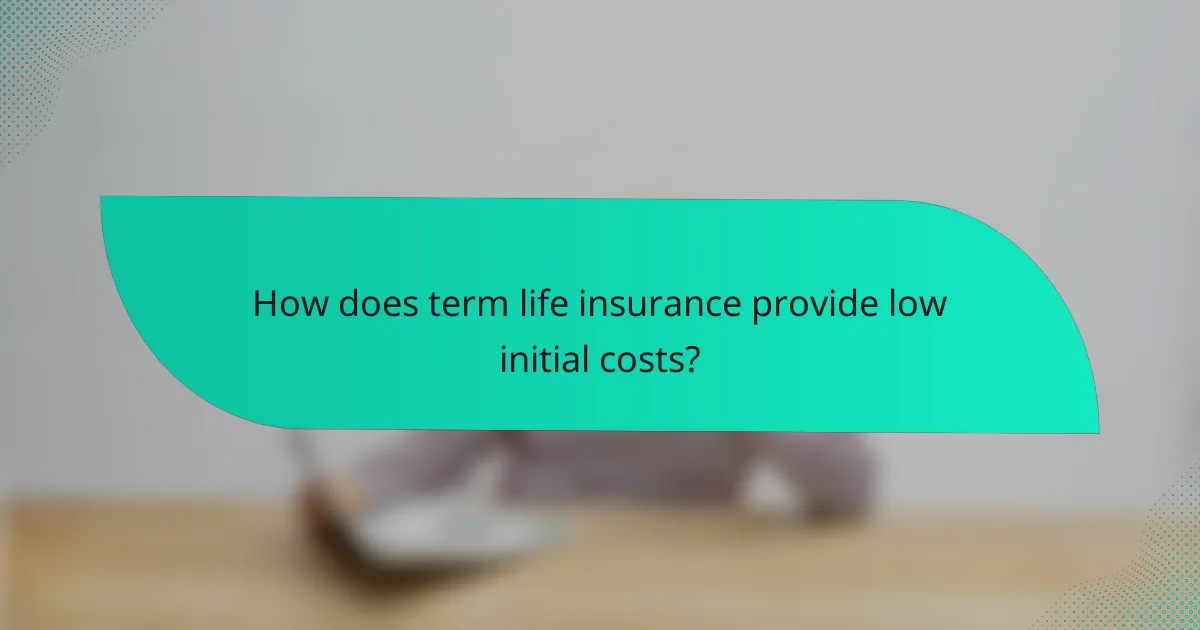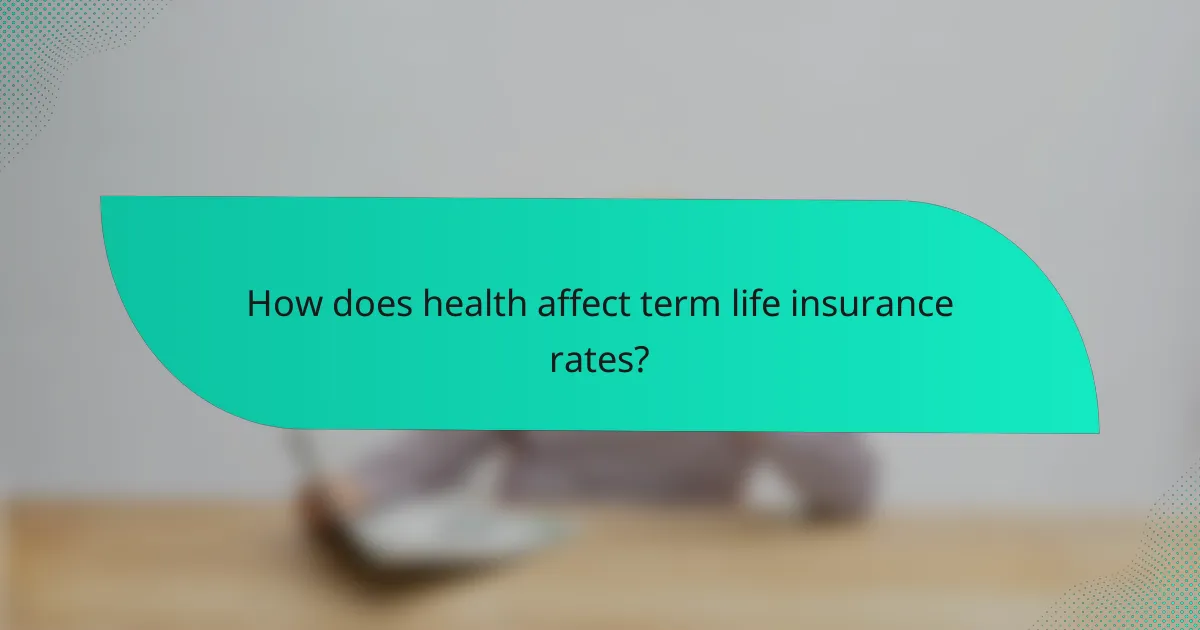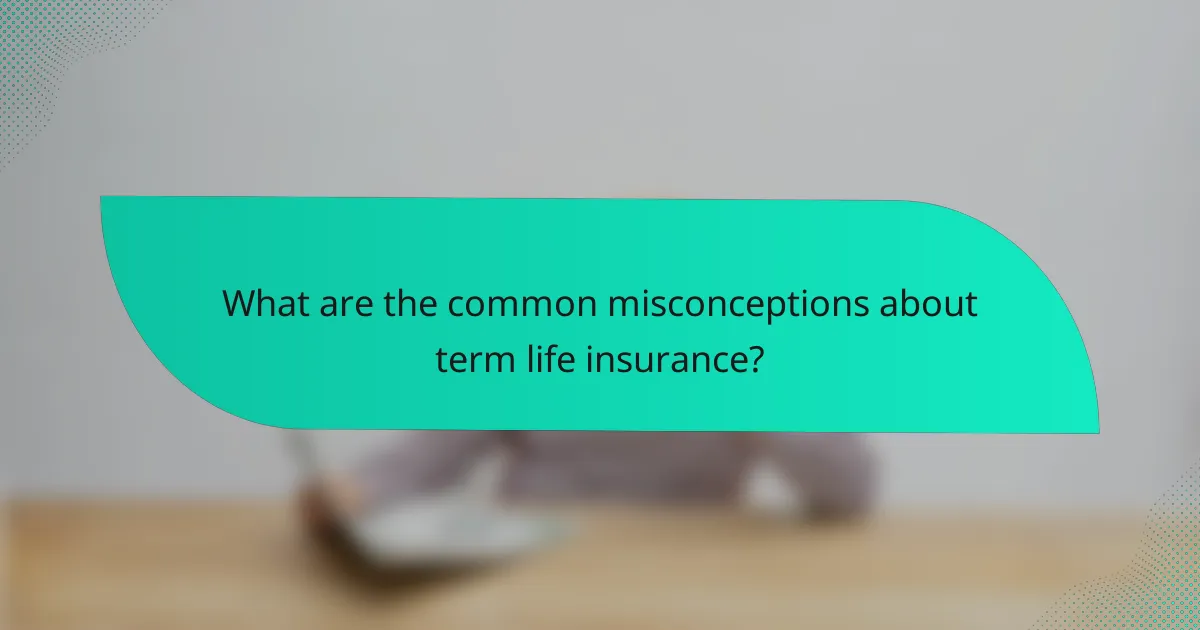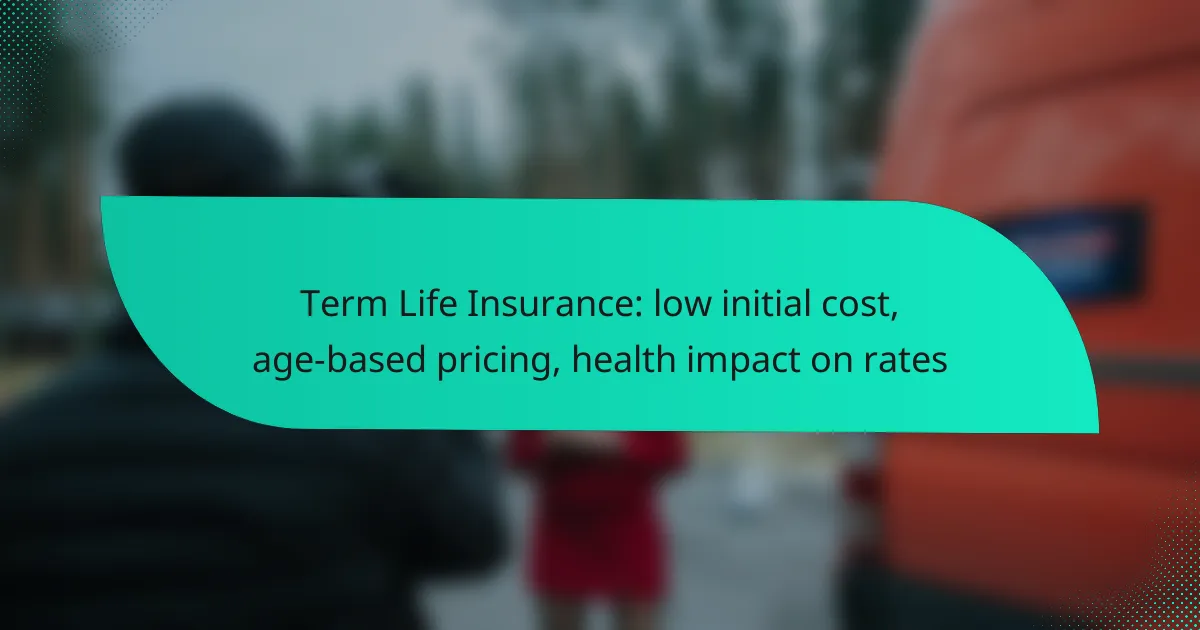Term life insurance is an affordable option for those seeking temporary coverage, with low initial costs that make it particularly appealing for younger, healthier individuals. Premiums are largely determined by age, health status, and the desired length of coverage, with rates increasing as one ages due to higher associated health risks. Additionally, a person’s health plays a crucial role in determining their premium, as insurers often offer lower rates to those with better medical histories.

How does term life insurance provide low initial costs?
Term life insurance offers low initial costs primarily due to its temporary coverage and straightforward structure. Unlike permanent policies, term life is designed to provide protection for a specific period, making premiums significantly lower, especially for younger individuals in good health.
Affordable premiums
Term life insurance typically features affordable premiums that can start as low as a few dollars per month for healthy individuals in their 20s or 30s. These low costs are largely due to the limited duration of coverage, which reduces the insurer’s risk compared to whole life policies.
When evaluating term life insurance, consider the length of the term you need. Common options range from 10 to 30 years, and premiums will generally increase with longer terms or as the insured ages. It’s advisable to compare quotes from multiple providers to find the best rates.
Comparison with whole life insurance
Term life insurance is often compared to whole life insurance, which provides lifelong coverage and includes a cash value component. Whole life premiums are usually several times higher than term premiums, making term life a more budget-friendly option for those seeking basic coverage without the investment aspect.
For example, a 30-year-old may pay around $20 per month for a $500,000 term policy, while a whole life policy for the same coverage could cost several hundred dollars monthly. This significant difference makes term life insurance an attractive choice for families looking for affordable protection during critical years.

What factors influence age-based pricing for term life insurance?
Age-based pricing for term life insurance is primarily influenced by the insured’s age at the time of application, health status, and the length of coverage desired. As individuals age, their risk of health issues increases, which can lead to higher premium rates.
Age brackets and premium rates
Insurance companies typically categorize applicants into age brackets, such as 18-30, 31-40, 41-50, and so on. Each bracket has its own premium rates, with younger individuals generally paying lower premiums due to their lower risk of mortality.
For example, a 30-year-old might pay a monthly premium in the low tens of USD, while a 50-year-old could see rates double or more. Understanding these brackets can help consumers plan their insurance purchases effectively.
Impact of life expectancy
Life expectancy plays a crucial role in determining term life insurance rates. Insurers use statistical data to assess the likelihood of policyholders living to certain ages, which directly impacts premium pricing.
As life expectancy increases, insurance companies may adjust their pricing models accordingly. For instance, if a demographic shows a trend of living longer, premiums may stabilize or even decrease for younger applicants, while older applicants might face higher costs due to increased health risks.

How does health affect term life insurance rates?
Your health significantly impacts term life insurance rates, as insurers assess your medical history and current health status to determine risk. Generally, healthier individuals receive lower premiums, while those with health issues may face higher costs or even denial of coverage.
Health conditions and underwriting
During the underwriting process, insurers evaluate pre-existing health conditions, such as diabetes or heart disease, which can lead to increased premiums. The severity and management of these conditions play a crucial role; well-managed conditions may result in more favorable rates compared to unmanaged ones.
For example, a 50-year-old with controlled hypertension may pay significantly less than someone with a recent heart attack. Insurers often require medical exams or health questionnaires to gather necessary information for accurate risk assessment.
Impact of lifestyle choices
Lifestyle choices, including smoking, diet, and exercise, also affect term life insurance rates. Smokers typically pay much higher premiums than non-smokers, sometimes by 20-30% or more, due to the increased health risks associated with tobacco use.
Maintaining a healthy lifestyle can lead to better rates. Regular exercise, a balanced diet, and avoiding high-risk activities can improve your health profile and potentially lower your insurance costs. Consider discussing your lifestyle with an insurance agent to understand how it may influence your premiums.

What are the benefits of term life insurance?
Term life insurance offers affordable coverage for a specified period, making it an attractive option for individuals seeking financial security for their loved ones. Its low initial costs and straightforward structure allow policyholders to provide essential support without breaking the bank.
Financial protection for dependents
Term life insurance provides crucial financial protection for dependents in the event of the policyholder’s untimely death. The death benefit can cover living expenses, mortgage payments, and education costs, ensuring that loved ones maintain their standard of living.
For example, a policy with a coverage amount of $250,000 might help a family manage their finances for several years, allowing them to adjust without immediate financial strain. Choosing the right coverage amount is essential to meet specific family needs.
Flexibility in policy terms
Term life insurance policies typically offer flexibility in terms of duration, with common options ranging from 10 to 30 years. This allows individuals to select a term that aligns with their financial obligations, such as raising children or paying off a mortgage.
Additionally, many insurers provide options to convert term policies to permanent coverage without undergoing further medical underwriting. This feature can be beneficial as health conditions change over time, ensuring continued coverage when needed most.

What are the drawbacks of term life insurance?
Term life insurance has several drawbacks, primarily its temporary nature and lack of cash value. While it offers low initial premiums, these factors can limit its long-term benefits for policyholders.
Temporary coverage
Term life insurance provides coverage for a specific period, typically ranging from 10 to 30 years. Once the term expires, the policyholder must either renew the policy at a higher rate or lose coverage altogether. This temporary aspect can be a disadvantage for those seeking lifelong protection.
For example, if you purchase a 20-year term policy at age 30, you will have coverage until you are 50. If you still need life insurance at that age, premiums may significantly increase due to your older age and any health changes.
No cash value accumulation
Unlike whole life insurance, term life policies do not build cash value over time. This means that while you pay premiums, you do not accumulate any savings or investment component. At the end of the term, if you have not passed away, you receive nothing back.
This lack of cash value can be a drawback for those who prefer a policy that serves as both insurance and an investment. Consider this when choosing a policy, as you may want to explore whole life or universal life options if cash value is important to you.

How to choose the right term life insurance policy?
Choosing the right term life insurance policy involves evaluating your coverage needs, comparing various policy options, and understanding how factors like age and health impact your premiums. Focus on finding a balance between adequate coverage and affordability to ensure you make a well-informed decision.
Assessing coverage needs
Start by determining how much coverage you require based on your financial obligations, such as mortgage payments, children’s education, and other debts. A common rule of thumb is to aim for a policy that covers 10 to 15 times your annual income.
Consider your dependents’ needs and future expenses when calculating coverage. For instance, if you have young children, you might want a higher amount to secure their education and living expenses in your absence.
Comparing policy options
When comparing term life insurance policies, look at the premium costs, coverage amounts, and the length of the term. Policies typically range from 10 to 30 years, and longer terms may offer higher premiums.
Evaluate additional features, such as the option to convert to permanent insurance or riders that can provide extra benefits. Always read the fine print to understand exclusions and limitations that may affect your coverage.

What are the common misconceptions about term life insurance?
Term life insurance is often misunderstood, leading to misconceptions about its affordability, target demographic, and overall value. Recognizing these myths can help individuals make informed decisions about their coverage options.
Misunderstanding affordability
Many people believe that term life insurance is too expensive, but it often offers low initial costs compared to other types of life insurance. Premiums can start as low as a few dollars per month, depending on factors like age and health.
It’s essential to compare quotes from different insurers, as prices can vary significantly. Additionally, locking in a policy at a younger age can lead to lower rates, making it a cost-effective choice for many.
Believing it’s only for young families
While term life insurance is popular among young families seeking financial protection, it is not exclusively for them. Individuals of all ages can benefit from term life insurance, especially those with financial obligations, such as mortgages or business loans.
Older adults may also find term life insurance appealing for covering final expenses or leaving a legacy. It’s crucial to assess your personal financial situation and needs rather than assuming term life insurance is only for a specific demographic.

What trends are emerging in term life insurance pricing?
Emerging trends in term life insurance pricing include the influence of telemedicine on underwriting processes and a shift towards personalized pricing models. These trends aim to enhance accuracy in risk assessment and offer more tailored premiums based on individual circumstances.
Impact of telemedicine on underwriting
Telemedicine is revolutionizing the underwriting process by allowing insurers to gather health information remotely. This can lead to quicker approvals and potentially lower premiums for applicants who may have previously faced higher rates due to health concerns.
For example, applicants can complete health assessments via video consultations, which can streamline the collection of necessary medical data. This method not only saves time but also reduces the need for invasive medical exams, making the process more accessible.
Shift towards personalized pricing models
Insurers are increasingly adopting personalized pricing models that consider individual health metrics, lifestyle choices, and even genetic information. This approach allows for more accurate risk assessments and can lead to lower premiums for healthier individuals.
For instance, a non-smoker with a healthy lifestyle may receive significantly lower rates compared to someone with pre-existing conditions. This trend encourages applicants to adopt healthier habits, as improved health can directly impact their insurance costs.
